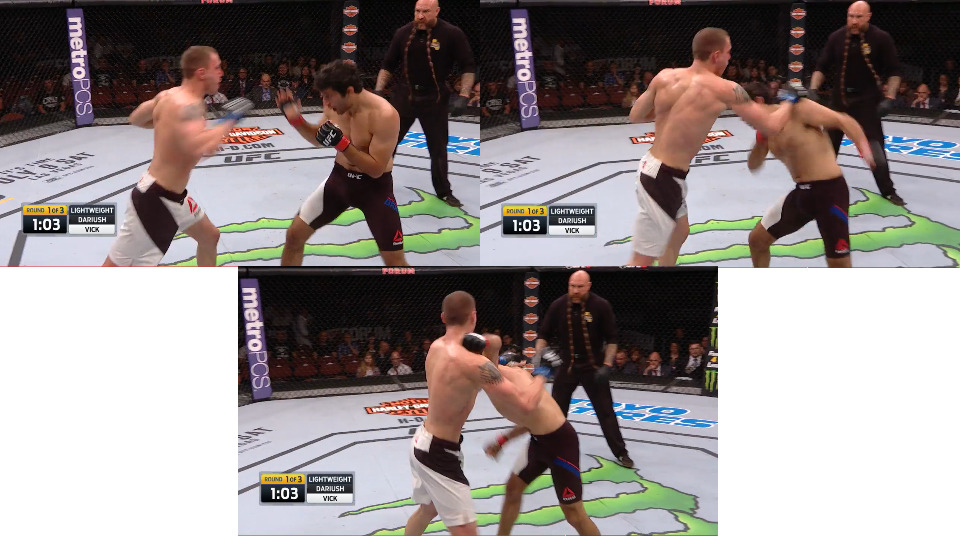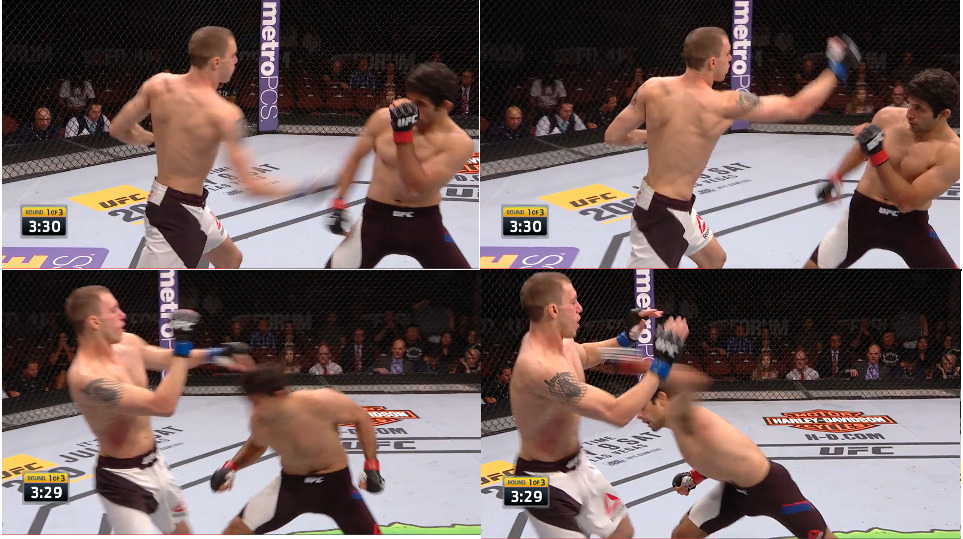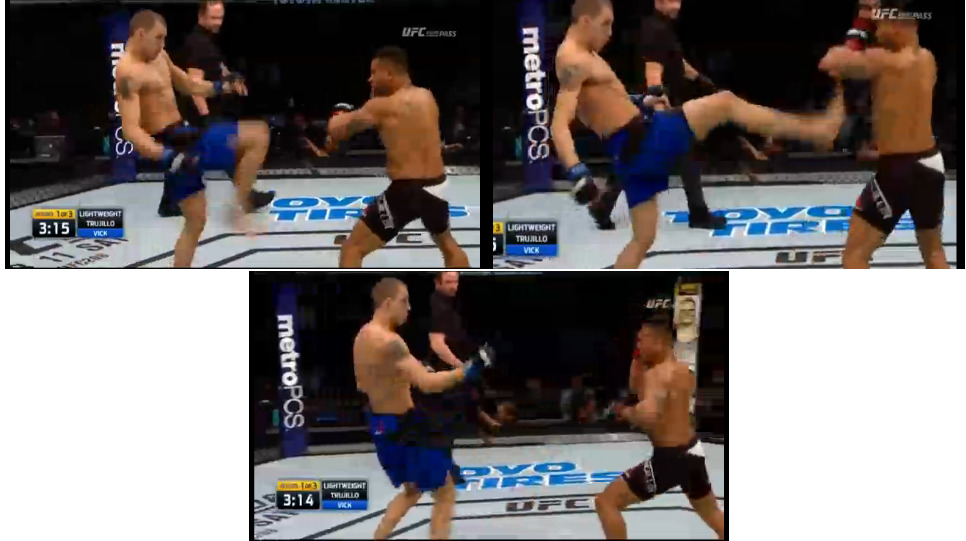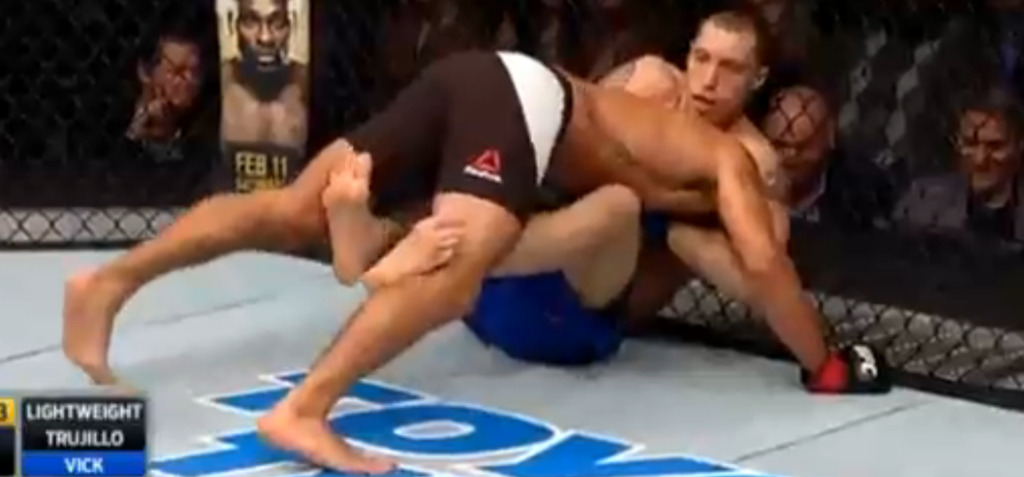The inherent advantages of height and reach are often taken at face value. People assume that the taller man walks into the octagon with an edge over his opponents every time. But reach and height can be a curse as much as a blessing. For every Jon Jones, there is a Stefan Struve. Fighters who have the natural control over distance often abuse that potential. They don’t learn the craft of closing distance because they don’t have too. As with fighters who are great athletes, long fighters sometimes skip key parts of technical development because they can get away with it. The Disadvantages of Length are just as real as the advantages. This brings us to James Vick.
Standing at an imposing 6’3″ with a 76″ reach, Vick towers over even the tallest fighters in the 155 pound division. He is a former golden gloves boxing champion who makes his money snatching submissions off the mat. His size is a big advantage for him but it is also the thing that gives him the most trouble. He has all the potential to cause havoc in his division, but in some ways his style is a great example of how fighting tall can go wrong.
On Saturday night, Vick pulled off the biggest win of his career when he battered Abel Trujillo for two rounds before submitting him in the third. While his submission skills are what closed the deal, what impressed me most about the fight was Vick’s commitment to closing some of the holes his length has created in his game. Using him as a case study, I want to talk about the disadvantages of length, then comment on how Vick improved upon them in his most recent performance.
James Vick: A Study In The Disadvantages Of Length
As a golden gloves champion, you would assume Vick’s boxing to be technically sound. What is interesting to note is that Vick bears the greatest hallmark of tall fighters: he is offensively focused and defensively irresponsible.
For most tall fighters, their length is their defense. The ability to hit someone when they can’t hit you leaves very little need to focus on defensive tactics. With a little ring awareness, you never need to put yourself in a position to be hit. Vick is a great example of a fighter who is at his best under very specific conditions. However he does struggle in certain areas that can be exposed at the upper levels of the division.
No Urgency At Distance
Vick throws good volume, he works behind a long jab, and he has good punch variety. He puts together three and four punch combinations very well. When he is able to move forward, Vick looks very much the part of a golden gloves winner. However often times Vick will stop and admire his work. He is slow to recover his punches and especially his kicks.
When you are the taller fighter fighting at range, you cannot be hit unless the opponent steps in. Being at a safe distance from your opponent at all times can lead to a dangerous lack of urgency. When Vick connects a punch, he rarely even acknowledges the possibility that his opponent can hit him back. Beniel Dariush put Vick in a world of trouble by letting him lead, then stepping in after Vick had thrown. Vick was caught completely unaware and was sent stumbling across the cage and suffered the only loss of his professional career.

1: Vick marches with his right hand, attempting to chase Dariush. 2: Rather than retreat, Dariush stands his ground and throws a counter. 3: Vick gets caught out of stance with his feet out of position and eats a hard counter while reeling in his missed right hand.
The Dangerous Kind Of Head Movement
On the occasions when his opponents do swing at his head in the open, Vick employs another tall man’s strategy. He will pull back at the waist and lean away from the shot. Because he operates at such a long distance compared to his opponents, Vick has more time to react to his opponents leads, so he doesn’t need to cut angles and pivot around his opponent or work constant head movement to make them miss. Instead he will just lean back.
The dangers of this tactic is that it works as long as his opponent does not account for his defensive movements. The reason averaged sized fighters do not lean back at the waist is because doing so leaves them very vulnerable to follow up shots once they have dodged the first. As Anderson Silva found out against Chris Weidman, pulling back at the waist leaves you very vulnerable if your opponent actually picks up on it.
Tall Footwork
As the taller man, reach is going to play a big factor in how they develop their footwork. Vick circles a lot, but he doesn’t have a lot of intent behind it. When pressured, he will retreat on a straight line. When attacking, he will come in on a straight line. This can be seen in other tall fighters like Luke Rockhold and Conor McGregor. When you have the reach advantage, getting an opponent to come forward and giving ground puts you in a position to hit them where they can’t hit you and takes them out of position to defend the shot. McGregor’s drawing of Jose Aldo is a perfect example of this.
The disadvantages of this are that retreating on a straight line is predictable. When Rockhold fought the smaller Michael Bisping, Bisping avoided Rockhold’s shots, then followed him back as he knew Rockhold would retreat on the same line he came in on. This is what allowed him to catch him cold and knock him out.
This problem also reared it’s head in Vick’s fight with Dariush. Dariush forced Vick up against the cage, and was sure to charge in through Vick’s retreats to catch him as he attempted to leave range. Because he was always retreating the same way, Vick ate shots again and again, even after landing his own.
The Rear Uppercut: The Tall Man’s Temptation
Another habit that Vick has in his boxing game that has given him more trouble than rewards is his use of the rear uppercut. The rear uppercut is a very powerful punch, and it is especially attractive to a tall fighter. An uppercut is at its most powerful when it is level with your shoulder. This means for most fighters that to land it effectively, you must force your opponent to duck.
In his book “Championship Fighting: Explosive Punching & Aggressive Defense”, former Heavyweight boxing champion Jack Dempsey wrote that an uppercut should only be used when you are chest to chest with your opponent, as it takes a long time to throw and recover the punch. Vick has no such issue, and as such he will throw the rear uppercut as a lead. Much like his fellow tall man Alexander Gustaffson, Vick throws his rear uppercut more frequently than he probably should. He will often throw it, miss it, then eat a counter as he is recovering his hand. It is not a punch that works that well for him in the open. he is as likely to get hit while throwing it as he is to hit his opponent with it.

Although he was saved most of the damage by virtue of an inadvertent eyepoke, this exchange perfectly illustrates how vulnerable Vick can be when he leads with a rear uppercut.
Marching Into The Clinch
Vick is a sufferer of what this writer has affectionately called Carlos Condit Syndrome. Much like “the natural born killer”, Vick is at his best from long range. Also like the former interim champion, Vick loves to close that distance every chance he gets. His flying knees are spectacular when they land, but when they miss he is jumping into a clinch. Even if they land, they sometimes see the same result.
Similarly when Vick is chasing his opponents, he will often step with his punches. This habit works well when the opponent retreats. However when they stand their ground and throw back (like Dariush did), Vick marches himself past his own range and into his opponents punches.
New year, New Vick?
This leads us to the main problems with being a tall fighter. Vick was a guy who could look great when given space to use his boxing, but he has always lacked defensive craft and worse, he would routinely give away his reach if his opponent didn’t stand still and let him hit them. He was vulnerable when his opponent stood and traded, and in his only career loss, what eventually sealed his fate was the discomfort he felt when his opponent was willing and able to get inside his reach. Dariush pressed forward, stood his ground, and followed Vick’s strikes back to him.
Coming in to his fight with the dangerous counter puncher Trujillo, Vick was going to be asked some of the same questions that troubled him against Dariush. Trujillo is not the kicker Dariush is, but he is a good wrestler who is a much bigger puncher.
From the outset Trujillo looked to cut the cage and force Vick to the cage. However, Vick stayed on top of his feet, and avoided the early charges by moving his feet, rather than his head. He was avoiding charges by angling off to his left, rather than just leaping backwards.
Kicking: Not Just For Kickers
Vick is not nor has he ever been a good kicker. He is almost glacially slow, and he does not recover his legs very well at all. After throwing, he will put his leg down out of stance and leave himself vulnerable to being hit.

Notice how when Vick kicks, his rear foot becomes his front foot as his leg retracts, leaving him in a much shorter stance than he was originally and in a position where it is much harder to move quickly.
However in this fight he was kicking frequently, and it played to his advantage. His kicks carry a much longer range than even his lanky arms. By adding an extra range for his opponent to worry about, he kept Trujillo uncomfortable and moving at all times. A big problem in his last fight with Dariush was that Dariush was able to kick Vick from punching range. By mixing in an extra range for him to worry about, he was able to prevent Trujillo from getting an accurate read on what his punching range actually was. This also helped him sell his next improvement.
Closing The Range
An interesting addition to Vick’s arsenal was his use of leg feints. According to commentator Brian Stann, Vick had spent some of his time since the Dariush loss in Thailand working on better utilizing his length. This showed in his adoption of a classic Muay Thai method of closing distance. Instead of simply running in with shots, he would pick up his leg to throw a kick, then put it down and step in with a punch. This allowed him to close the distance without giving his range to Trujillo or taking him out of his stance.
Jorge Masvidal recently used this technique to close the distance against Donald Cerrone. It was just as effective here for Vick, as it kept him from having to rush into strikes. He was also much happier to let Trujillo retreat. Rather than chasing, he would simply get back to the center of the cage and start again.
The Dangers Of A Non-Lethal Guard
An interesting part of Vick’s game which has flown a little under the radar is his work from the guard. Rather than being particularly dangerous, Vick has developed a guard that forces his opponent to work more than him. Because of his length, Vick will establish grapevines on his opponents legs and look to wrap up a guillotine. It is not an easy submission to finish from this position. To get the right amount of leverage the legs would have to wrap around his opponents body and pull them closer. But with his long arms Vick can threaten the choke relatively easily. By using his legs to elevate his opponents, he prevents them from generating much offence and makes it difficult for them to advance position.

With his legs wrapping Trujillo’s and elevating, he limits his movement and his ability to easily posture up to deliver strikes, while threatening a choke that forces him to defend it while restricting his breathing
The ability to exhaust an opponent from this position can be invaluable in a fight. In both his fight with Glaico Franca and Trujillo, Vick used this tactic to wear out his opponent from a position where most fighters go to take a break. They may not get submitted from there, but that is only if they pay attention. They must fight the hands and look to free their legs. Just because it isn’t an immediate threat doesn’t mean they can simply ignore it. Even if doing so is relatively straightforward, the energy they expend comes at with very little tactical rewards.
Franca never made much progress past Vick’s guard when he took him down. Every time he got up, he looked a little more diminished. After fighting out of this position early in the first round of their fight, Trujillo began to look a lot more wild in his rushes to close the distance on the feet. His charges became laborious, and every time he looked to take Vick down, he put himself in more and more danger without getting the chance to recover he seemed to be looking for.
Final Thoughts
This is not to say that Vick’s performance was perfect. He still threw that lead uppercut naked and got clipped off it. The flying knee put Trujillo on wobbly legs once, but just he missed it three other times. He still pulled his head back and he still retreated on straight lines at points. But the important part is that he mixed it up. No strategy in combat sports is foolproof. Everything comes with pros and cons. By being more diverse, by offering more options, Vick reduced the risks of his more risky habits.
James Vick is a fighter who clearly understands the advantages of being a tall fighter. What his last fight showed was that he is now beginning to understand the disadvantages as well. He is slowly making changes to enhance his rewards while minimizing the risks. If he continues to develop this strategic mindset, the lightweight division could soon be looking at a very real threat.



